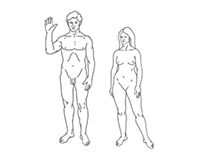Payot [pey-oht] is the Hebrew word for sidelocks or sideburns. Payot are worn by some men and boys in the Orthodox Jewish community based on an interpretation of the Biblical injunction against shaving the ‘corners’ of one’s head. Literally, ‘pe’ah’ means ‘corner, side, edge.’
There are different styles of payot among Hasidic, Yemenite, and Chardal (Zionist Israeli) Jews. Yemenite Jews call their sidelocks ‘simonim,’ literally, ‘signs,’ because their long-curled sidelocks served as a distinguishing feature in the Yemenite society (differentiating them from their non-Jewish neighbors).
The Torah (the Old Testament) says, ‘You shall not round off the pe’ah of your head.’ The Mishnah (the oral history of Jewish law) interpreted the regulation as applying only to men. Thus it became the custom in certain circles to allow the hair over the ears to grow, and hang down in curls or ringlets. According to 12th century Torah scholar Maimonides, shaving the sidelocks was a heathen practice. There is considerable discussion in the halachic literature (corpus of rabbinic legal texts) as to the precise location of the payot and of the ways in which their removal is prohibited.
As kabbalistic teachings (Jewish mysticism) spread into Slavic lands, the custom of payot became accepted there. In 1845, the practice was banned in the Russian Empire. Crimean Karaites did not wear payot, and the Crimean Tatars consequently referred to them as ‘Jews without payot,’ to distinguish them from the Krymchaks (‘Jews with payot.’ Many Hasidic and Yemenite Jews let their sidelocks grow particularly long. Some Haredi men grow sidelocks, but trim them or tuck them behind the ears. Even in some communities where payot are not customary among the men, young boys may grow them until the age of bar mitzvah.
The lengths and maintenance of the payot vary noticeably among Jewish groups. Satmar Jews, a Hasidic group originating from the city of Szatmárnémeti, Hungary (now Satu Mare, Romania), have notably thicker sidelocks. They also tend to tuck their sidelocks behind their ears. Belz Hasidim (a Hasidic dynasty founded in the town of Belz in Western Ukraine, near the Polish border) wrap their sidelocks around their ears as many times as necessary without trimming.
Many Breslov Hasidim (a branch of Hasidic Judaism founded by Rebbe Nachman of Breslov, great-grandson of the Baal Shem Tov, founder of Hasidism) wear long twisted locks as did their Nachman. However, others wear different styles in line with the teaching of Rabbi Nachman that his followers do not have to have a uniform garb. The Chabad-Lubavitch (one of the largest Hasidic groups) wear payot that are not evident, but so long as there is hair around the ear and behind it that can be plucked out, that is considered payot.
Some Gerer Hasidim (a dynasty originating from a small town in Poland) raise their sidelocks from the temples and tuck them under their yarmulke. Others, especially in Israel, let them hang down. The Skver Hasidim (originating in present day Ukraine) twist their sidelocks into a tight coil, and leave them protruding in front of the ear. Some traditional Yemenite Jews still wear distinctive long and thin twisted locks, often reaching to the upper arm. The actual area where the hair grows and where the ringlet begins is neat and tidy. Most other Hasidic groups wear their payot down and curled.
Lithuanian Jews are less influenced by Kabbalistic practices, but still retain sidelocks to a degree, in a small number of variant styles. For example, they often cut their sidelocks, but leave a bunch of strands uncut, and place them behind the ear; this style is most commonly found among yeshiva students, who sometimes remove the uncut strands when they have grown sideburns.
The Brisk movement’s (based on the Brisker method of Talmudic study) members brush their hair straight down, usually so that it reaches to the ear lobe; sometimes, some of the sidelock is not cut, and is curled back behind the ear.
The Daily Omnivore
Everything is Interesting



Leave a comment